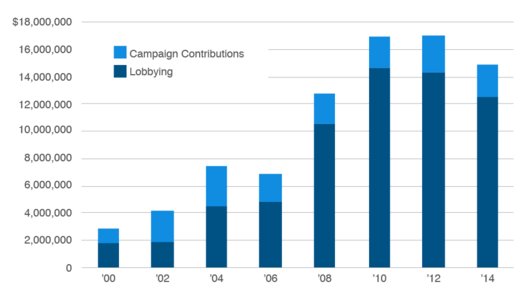Walmart PESTEL Analysis
PESTEL is a strategic analytical tool and the acronym stands for political, economic, social, technological, environmental and legal factors. Walmart PESTEL analysis involves the analysis of potential impact of these factors on the bottom line and long-term growth prospects.
Political Factors
Because of its massive size and significance for the US economy, Walmart has been observed to interfere with politics a number of times. The primary reasons for Walmart’s political interferences via lobbying and other means have been an attempt to gain positive political impact on the business. In 2013 Walmart has been caught convincing employees to make political contributions to republicans to support pro-business conservatives like Cruz and Boehner[1]. Walmart has been ranked among the top 100 political donors overall for the period since 1989[2]. As it is illustrated in Figure 5 below, Walmart political spending has vastly increased during the past one and half decade and these funds have been used to influence corporate tax and labour legislations to a certain extent.[3]
Changes in Walmart’s political spending[4]
Apart from campaign contributions and lobbying activities, Walmart has attempted to interfere directly in certain political debates a number of times. In one notable case, Walmart voiced its opposition to religious freedom law in its home state of Arkansas in 2015. Arguing that religious freedom laws would open the door to discrimination against gay and lesbian customers, Walmart emerged victorious and Republican Gov. Asa Hutchinson refused to sign the legislation.[5]
Additionally, Walmart is impacted by a wide range of political factors such as political stability in places where the company operates, market lobbying protectionism policies in international markets, the freedom of press, extent of corruption and others.
Economic Factors
Walmart revenues and profits are impacted by a range of external economic factors either, directly or indirectly. For example, currency exchange rate between USD and other major currencies is a significant factor that has direct implications on Walmart profits. In Q4 2015 sales in Walmart US increased by 2.4 per cent to USD 81.5 billion. However, the U.S. revenue gains were offset by a 9.7% decline to USD32.7 billion in international sales, which saw a negative impact of USD4.7 billion from foreign currency exchange fluctuations.[6] In other words, strong USD relation to other currencies had negative impacts on sales in 2015 due to the global scale of Walmart operations.
Cost of labour is another important economic factor that effects revenues for Walmart, as well as, revenues of any other business. The company has been traditionally criticized for paying employees low wages, although Walmart has no other option in order to be able to sustain cost leadership competitive advantage in the market. Nevertheless, amid growing criticism, Walmart had to raise minimum wages to its workers in the US to USD 9 an hour in April 2015 and this caused the decline of earnings by 2 cents a share during the second quarter of 2015.[7]Nevertheless, it is important to note that although employee wage increases has obvious negative implications on revenues and profits in short-term perspective, the implications of this change no the bottom line for long-term perspective can be positive via increased employee morale and performance.
An additional range of economic factors that effects Walmart include a macroeconomic climate and economic stability in the country, changes in tax rates, unemployment rate, interest rates and others…
Walmart Stores Inc. Report contains the full discussion of Walmart PESTEL analysis. The report also illustrates the application of the major analytical strategic frameworks in business studies such as SWOT, Porter’s Five Forces, Value Chain analysis and McKinsey 7S Model on Walmart. Moreover, the report contains analysis of Walmart’s marketing strategy, its leadership and organizational structure and discusses the issues of corporate social responsibility.
[1] Easley, J. (2013) “Walmart Gets Busted Forcing Employees to Make Political Contributions to Republicans” Politicus USA, Available at: http://www.politicususa.com/2013/12/23/walmart-busted-forcing-employees-political-contributions-republicans.html
[2] Ruetschlin, C. & McElwee, S. (2015) “The Big Influence of the Big Box” Prospect, Available at: http://prospect.org/article/how-walmart-and-home-depot-are-buying-huge-political-influence
[3] Ruetschlin, C. & McElwee, S. (2015) “The Big Influence of the Big Box” Prospect, Available at: http://prospect.org/article/how-walmart-and-home-depot-are-buying-huge-political-influence
[4] Source: Center for Responsive Politics
[5] Lee, MJ. (2015) “Is the GOP losing Walmart?” CNN Politics, Available at: http://edition.cnn.com/2015/04/01/politics/walmart-religious-freedom-bill/
[6] Tenebruso, J. (2016) “Wal-Mart Stores Inc. Slashes Sales Outlook” The Motley Fool, Available at: http://www.fool.com/investing/general/2016/02/19/wal-mart-stores-inc-slashes-sales-outlook.aspx
[7] Monica, R.P. (2015) “Walmart’s profits hurt by wage hike for employees” CNN Money, Available at: http://money.cnn.com/2015/05/19/investing/walmart-sales-earnings-consumer-spending/


